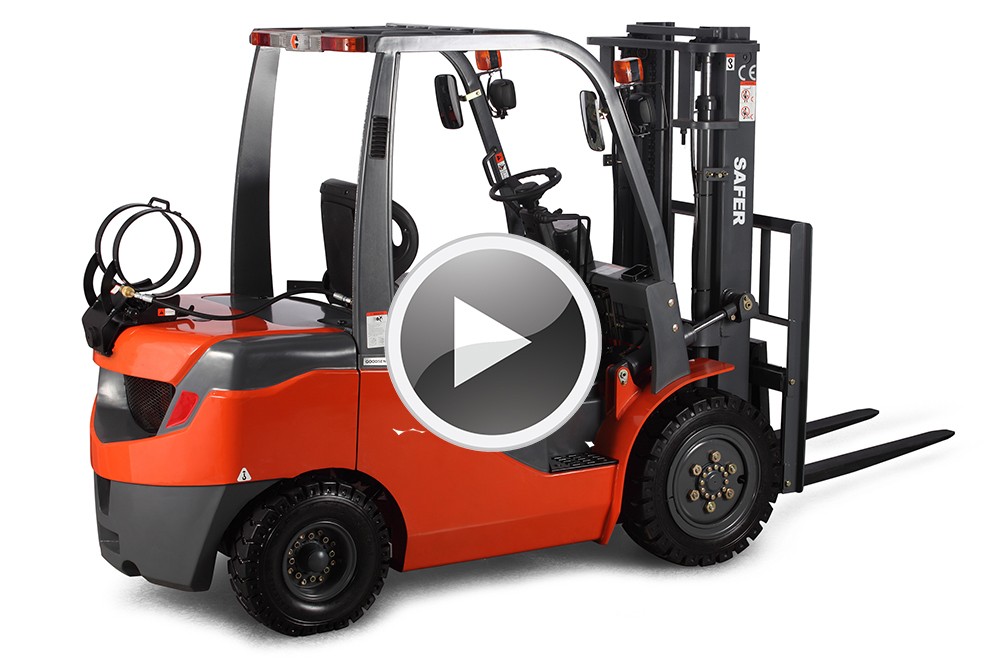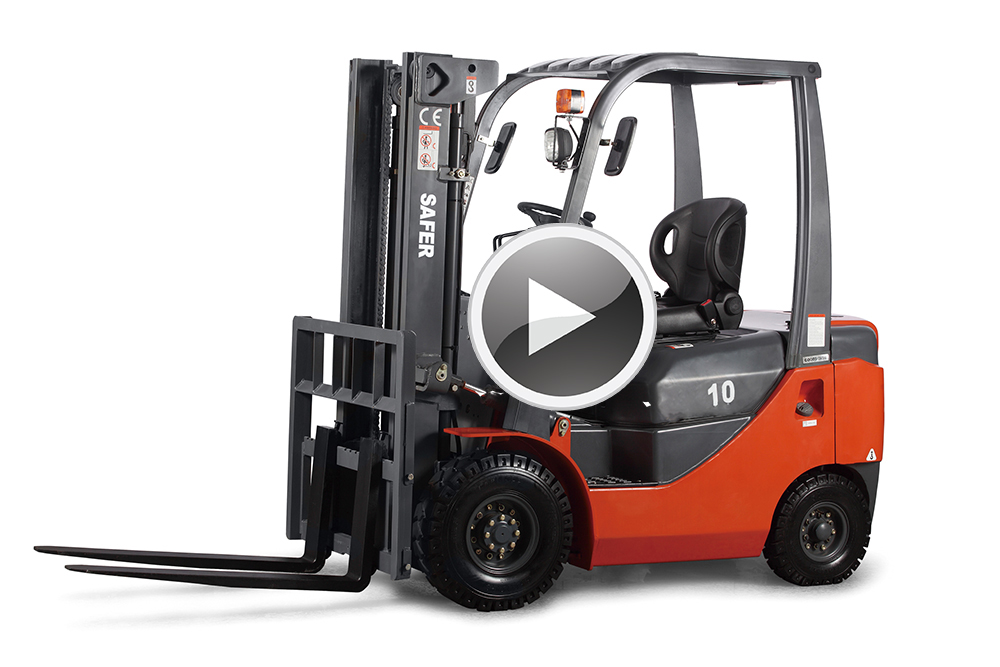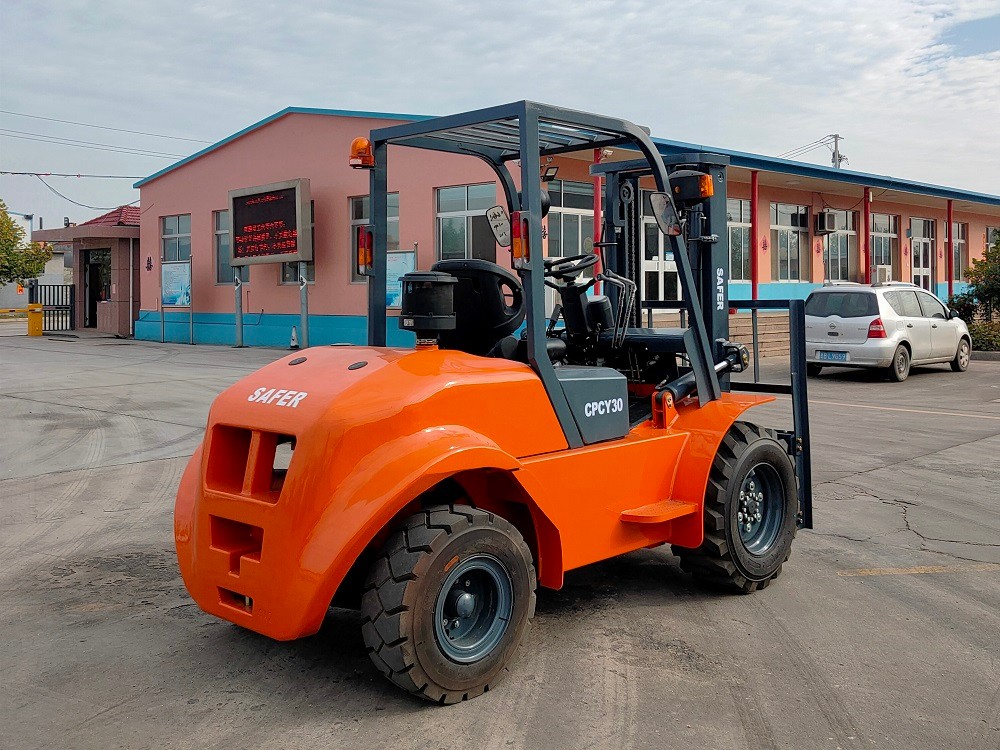1. What is the maximum lifting weight and load center? What is their relationship?
Answer: When the center of gravity of the cargo is in the same vertical line as the load center, the maximum weight of the forklift truck can be loaded and unloaded, which is called the maximum lifting weight of the forklift; the horizontal distance from the center of gravity of the standard load to the front wall of the vertical section of the fork is called the load center of the forklift. . Usually, the load centers are different according to the standard specified at the time of design, that is, the different lifting weights. When the center of gravity of the cargo is within the load center, the forklift can be loaded and unloaded with the maximum lifting capacity, otherwise the stability of the forklift will be damaged and the accident will occur.
2 What is the stability of the forklift?
A: The stability of the forklift refers to the ability of the forklift to carry out loading and unloading operations and resisting overturning when driving on various roads. It can be divided into longitudinal stability and lateral stability. Longitudinal stability refers to the ability of a forklift to resist rolling over a longitudinal direction of the axle. Lateral stability refers to the ability of the forklift to resist rollover and side slip.
3. How should the fork and gantry stop after the forklift works?
Answer: After the forklift works, the fork must be lowered to the ground, and the gantry should be returned to the original position (vertical center). The purpose is to provide unloading protection for the hydraulic system to avoid deformation and damage of various components (especially sealing components) in the hydraulic system due to prolonged compression.
4. What are the reasons for the forklift frame shake and the door frame automatically tilting forward and backward?
A: The reason for the jitter:
(1) The gap between the gantry support pin and the copper sleeve is too large
(2) The gap between the inner and outer gantry sliding steel plates is too large
(3) The two starter chains are not tight
(4) Excessive roller wear
Reasons for automatic forward and backward tilting:
(1) Damage to the inclined cylinder seal
(2) Multi-way valve sink
5. What is the reason for the automatic decline after the fork is lifted?
Answer: (1) Piston cup is aged or damaged
(2) The clearance between the lifting cylinder and the piston is too large
(3) The gap between the hydraulic distributor lifting cylinder and the lifting valve stem is too large
(4) Pipe or joint oil leakage
6. What is the reason why the fork lift speed is too slow and cannot rise?
A: The reason for the slow rise is:
(1) Oil pump wear or oil leakage
(2) Distributor safety valve spring pressure is too low or steel ball and seat wear
(3) The gap between the distributor lifting cylinder and the lifting valve stem is too large
(4) The gap between the lifting cylinder and the piston is too large, or the cup is aging and damaged.
(5) Pipeline or joint oil leakage
(6) One-way throttle valve is not working
The reason why the fork can not rise
(1) Oil tank lack of oil
(2) The pipe joint is clogged or severely leaking oil
(3) Oil pump damage
(4) The safety valve spring is broken or permanently deformed
7. What are the types of forklift maintenance? What is the time interval?
A: The maintenance of forklifts is divided into four categories, namely daily maintenance, primary maintenance, secondary maintenance, and tertiary maintenance. Daily maintenance is a daily maintenance. Usually, every level of maintenance is performed after 50 hours of work. After every 200 hours of work, secondary maintenance is carried out, and after three hours of work, three levels of maintenance are performed.
8. What is the daily maintenance of the forklift?
A: The specific content is:
(1) Check the amount of oil in the engine crankcase and air cleaner, the amount of fuel in the fuel tank, and the amount of cooling water in the radiator. If it is insufficient, add it as required.
(2) Check the height of the electrolyte surface in the battery, add it as needed, and keep the air hole of the cover clear, and the pole and wire joints are tightly connected.
(3) Check the free travel and working reliability of the hydraulic brake and hand brake, and add brake fluid and remove air from the system as needed.
(4) Check the tire pressure and remove the debris embedded in the tread.
(5) Check the amount of working oil in the fuel tank of the vehicle hydraulic system and whether there is leakage at the pipe, joints, etc.
(6) Check the water level of the fire extinguishing water tank.
(7) Check the operation of instruments, lights, speakers, etc.
(8) After the above checks are completed, start the engine, check the engine operation, and check whether the drive train, brake system and hydraulic lift system are working properly.
9. What is the main content of the level 1 maintenance of the forklift?
Answer: (1) Check the engine oil quantity, oil viscosity and the degree of dirt in the oil.
(2) Clean the battery and add distilled water as needed.
(3) Check the appearance of the fan belt and its tightness.
(4) Check the gearbox, drive axle, working oil pump, and pump drive unit for abnormal noise.
(5) Add oil or grease to all parts of the longitudinal link of the clutch and brake as required.
(6) Check the wear of the lift cylinder and the tilt cylinder piston rod. If there is a slight scratch, use oil stone or fine sand cloth to smooth.
(7) Check and tighten the bolts and nuts of the tire.
10. What are the main tasks of the secondary maintenance of the forklift?
Answer: (1) Clean the inside of the engine oil pan, crankcase and oil filter, and replace the new oil.
(2) Clean the fuel tank and check the fuel line and the oil pump joint for looseness or oil leakage.
(3) Check the distributor's power-off contacts and adjust the period clearance.
(4) Check and tighten the bolts on the exposed parts of the generator.
(5) Check the discharge capacity of the battery and charge as needed.
(6) Replace the cooling water in the radiator.
(7) Check and adjust the free travel of the clutch and brake pedal and the brake clearance of the wheel brake.
(8) Discharge the sediment and water at the bottom of the working tank, clean the filter and add new oil as appropriate.
(9) Check whether the tightness of the two heavy chains is consistent.
(10) Check the forklift truck's iron and fork parts for deformation and cracking.
11. What are the main tasks of the three-level maintenance of forklifts?
Answer: (1) Adjust the valve clearance.
(2) Measure the cylinder pressure and check the cause of the non-requirement.
(3) Check the working performance of the clutch and adjust it as needed.
(4) Check the free travel of the steering wheel and the connection of the steering tie rods, and check the wear of the steering pin and the steering sector pin.
(5) Check the bearing wear of the clutch and brake pedal shaft.
(6) Thoroughly clean the forklift and inspect and tighten all bolts and nuts on the exposed parts.
12. What are the safe operating procedures for forklifts?
A: (1) Check the vehicle
(1) Before the operation of the forklift, the appearance should be checked, and fuel, lubricating oil and cooling water should be added.
(2) Check start, run and brake performance.
(3) Check whether the lighting and sound signals are complete and effective.
(4) Check whether the pressure and temperature are normal during the operation of the forklift.
(5) After the forklift is running, the external leakage should be checked and the seals replaced in time.
(6) In addition to checking the above contents, the battery forklift should also check the circuit of the battery forklift according to the relevant inspection contents of the battery car.
(2) Getting started
(1) Before starting, observe the surrounding area and confirm that there are no obstacles to the safety of driving, first whistle and start later.
(2) For vehicles with air brake, the brake barometer reading must reach the specified value before starting.
(3) When the forklift starts, the driver should first confirm that the cargo is stable and reliable.
(4) Start slowly and smoothly at the start.
(three) driving
(1) When driving, the height of the bottom end of the fork should be 300-400mm from the ground, and the gantry must be tilted backward.
(2) Do not raise the fork too high when driving. When entering or leaving the work site or on the road, pay attention to the obstacles in the sky. When the load is driving, if the fork rises too high, it will increase the overall center of gravity of the forklift and affect the stability of the forklift.
(3) After unloading, the fork should be lowered to the normal driving position before driving.
(4) When turning, if there are pedestrians or vehicles nearby, signals should be sent and high-speed sharp turns should be prohibited. High-speed sharp turns can cause the vehicle to lose its lateral stability and tip over.
(5) Internal combustion forklifts are strictly prohibited from stalling when going downhill.
(6) Non-special circumstances, it is forbidden to brake the load while driving.
(7) When the load travels more than 7 degrees and goes up and down with a speed higher than the first gear, the brake shall not be used in non-special circumstances.
(8) The forklift must comply with the in-plant traffic rules during operation and must maintain a certain safety distance from the front of the truck.
(9) When the forklift is running, the load must be at the lowest position that does not hinder the driving. The gantry should be properly tilted backwards. When stacking or loading, the load should not be increased. When carrying a large object, the object blocks the driver's line of sight, and the forklift should be turned down at this time.
(10) The forklift is controlled by the rear wheel, so you must always pay attention to the swing behind the car to avoid the sudden turn of the car that often occurs when the beginner drives.
(11) It is forbidden to turn on the slope and not to cross the ramp.
(12) When the forklift truck is going downhill, it should be reversed to prevent the cargo from falling down.
(4) Loading and unloading
(1) When loading the goods, adjust the distance between the two forks as needed to balance the load of the two forks. Do not deflect. One side of the item should be placed against the shelf. The weight of the fork should meet the requirements of the load center curve sign.
(2) The height of the load shall not obstruct the driver's sight.
(3) The brake must be braked with the brake during the loading and unloading of the item.
(4) When the forklift truck approaches or evacuates the goods, the speed of the vehicle should be slow and steady. Pay attention to the wheels and do not crush the objects, wooden mats, etc., so as to prevent the crushed objects from flying and injuring people.
(5) When picking up the goods with forks, the forks should be forked as far as possible into the load, and the fork tip should not touch other goods or objects. The minimum gantry back tilt should be used to stabilize the load so that the load does not slide backwards. When the load is lowered, the gantry can be tilted forward a small amount to facilitate loading and unloading the fork.
(6) It is forbidden to fork the cargo at high speed and collide with hard objects with forks.
(7) When the forklift is in operation, it is forbidden to stand on the fork.
(8) Forklift forklift operation, it is forbidden to stand around the fork to prevent the goods from collapsing and injuring people.
(9) It is forbidden to use the forklift to lift personnel to work in high places, so as to avoid accidents in high places.
(10) It is not allowed to use the brake inertia to slide the item.
(11) It is not allowed to directly load the cargo on board the shore of the dock.
(12) Single-fork work is prohibited.
(13) Overloading operations are prohibited.
13. What are the safety technical conditions of the forklift crane structure?
Answer: (1) The deformation of the gantry and the phenomenon of weld seam de-welding. The rolling clearance of the inner and outer gantry should be adjusted reasonably, no more than 15mm, the rolling rotation should be flexible, and the roller and shaft should be free of cracks and defects. The amount of wheel groove wear must not exceed 10% of the original size.
(2) The tension of the two lifting chains should be uniform, no distortion, and the ends should be firmly connected. The pitch of the chain should not exceed 4% of the length. Otherwise, the chain should be replaced. The sprocket rotation should be flexible.
(3) The forks shall not be severely deformed; there shall be no cracks on the surface of the fork; the welds of the joints shall not have the phenomenon of desoldering, the root angle of the fork shall not be greater than 93%, and the thickness shall not be less than 90% of the original size; The height difference shall not exceed 3% of the length of the horizontal section of the fork; the positioning of the fork shall be reliable, and the bearing surface and the positioning surface of the fork shall not have obvious defects; the clearance between the fork and the fork shall not be too large and the movement shall be smooth. .
(4) The joint between the lifting cylinder and the door frame should be firm. The hinge of the tilting cylinder and the door frame and the frame should be firm and flexible, and the matching clearance should not be too large. The cylinder should be well sealed, crack-free and stable. Under the rated load, the self-sinking of the gantry is not more than 20mm and the inclination is not more than 0.5 degrees. The lifting speed is not less than half of the standard value at full load.
14. What are the safety technical conditions for the hydraulic control system of the forklift?
Answer: (1) The hydraulic system pipeline joint is firm and has no leakage, and the other mechanical parts are not worn. The rubber hose must not be aging or deteriorating.
(2) The transmission components in the hydraulic control system should not crawl, stagnate and obviously impulsive in the rated load and rated speed range.
(3) The multi-way reversing valve housing has no cracks or leakage. The working performance is good and reliable; the safety valve is sensitive, and should be fully open when the overload is 25%, and the nut of the adjusting bolt should be fully tightened. The operation handle is positioned accurately and reliably, and must not be displaced due to vibration.
(4) The load curve and hydraulic control nameplate should be complete and fresh.
15, full hydraulic forklift needs to know
(1) The torque converter oil quantity needs the oil dipstick to mark the addition of the torque converter oil. No. 8 liquid lift transmission oil winter 22nd. Summer 30th turbine oil.
(2) The normal working oil temperature of the torque converter is 90 degrees ± 10 degrees.
(3) The oil temperature needs to be cooled by 100 degrees. So as not to affect the performance and life of the vehicle.
(4) The torque of the torque converter is 12±1 kg. The pressure will affect the performance and life of the work.
Pre:take you to understand some problems with the forklift and how to eliminate it cause of issue:
Next:Disassembly method of hydraulic pipeline system in electric forklift maintenance



